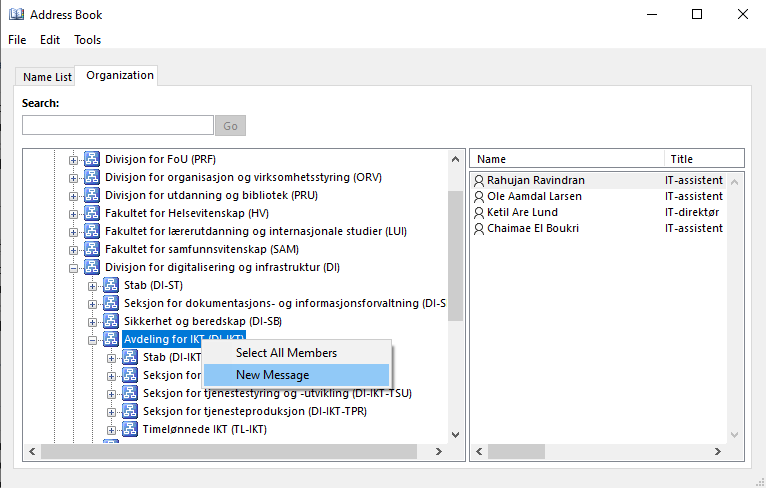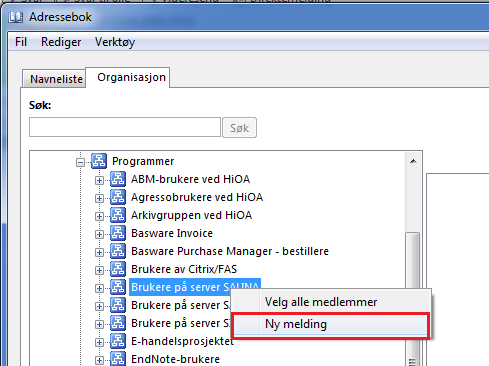E-mail lists
E-mail lists in Outlook address book
Find all the main e-mail lists in the address book in Outlook.

-
Email lists (by organisation)
You will find the lists in the address book in Outlook under the Organisation> Employees (by organisation).
Automatic lists are generated by organisational affiliation, and they only change in the event of new or changed working conditions.
Right click on the list to send a message: Choose "New Message"

Important
Please Note! If you use an email address at the top level of the organizational structure, for example, sending an email to a faculty, everyone in the faculty will receive this email.
The email list will include all email addresses under the top level. Therefore, you should navigate down to the desired unit or email list before sending the message.
-
Other lists
Under Other lists, you will find all lists that are not created on the basis of organisational or class affiliation.

You will find lists according to local identity, variety, associations and other groups, places etc.
The lists can be found in the address book in Outlook under the tab Organisation > Other lists. See the screenshot below.
When you send an email to the list, you will send it to all the members of the list in question.
-
Student lists
E-mail lists at the top level
Note that if you for instance wish to send an email to a faculty, all the faculties will receive this email when you are using an email address at the top level of the organisational structure of Outlook.
The email list is linked to all email addresses below the top level. You should therefor scroll down to the desired unit or email list before sending your email.
Name of student lists
The lists are automatically created from the information registered in the student register FS, the National Student Database
Changes in FS will therefore lead to corresponding changes in the student lists that are updated every night.
The lists are generated based on the following data in FS: Location - faculty, institutes and groups
-
Format: stud-<type>-<stedsnavn>-liste@oslomet.no.
Examples
-
stud-fakultet-tkd-liste@oslomet.no
-
stud-institutt-iprod-liste@oslomet.no
-
stud-gruppe-pd-prdem-liste@oslomet.no
Group
-
Format: stud-gruppe-studieprogram-<studieprogramkode>-liste@oslomet.no
-
Example: stud-gruppe-pd-prdem-liste@oslomet.no
Programme of study
-
Format: stud-studieprogram-<studieprogramkode>-liste@oslomet.no
-
Example: stud-studieprogram-mapd-liste@oslomet.no
Year group
-
Format: stud-kull-<studieprogramkode>-liste@oslomet.no
-
Example: stud-kull-mapd-h2011-liste@oslomet.no
Class
-
Format: stud-klasse-<studieprogramkode>-<terminbokstav><årstall>-<klassekode>-liste@oslomet.no
-
Example: stud-klasse-mapd-h2011-a-liste@oslomet.no
-
-
How to create an e-mail list
You can create a group in Microsoft 365 Copilot and add members. You interact with the group by sharing documents/files etc. and emails in a group space - also available in Outlook Online.
Groups in Microsoft 365 Copilot replaces previous mailing lists.
